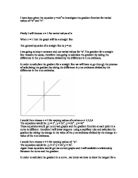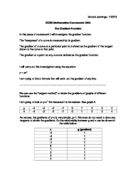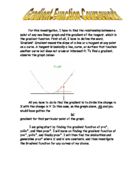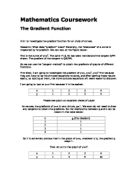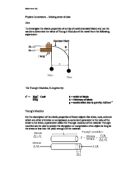I have been given the equation y = axn to investigate the gradient function for varied values of "a" and "n".
I have been given the equation y = axn to investigate the gradient function for varied values of "a" and "n" Firstly I will choose n = 1 for varied values of a When n = 1 then the graph will be a straight line The general equation of a straight line is y = ax I am going to keep n constant and use varied values for "a".The gradient for a straight line remains the same, therefore I am going to calculate the gradient by taking the difference in the y co-ordinates divided by the difference in x co-ordinates. In order to calculate the gradient for a straight line we will have to go through the process of calculating the gradient by taking the difference in y co-ordinates divided by the difference in the x co-ordinates. I would then choose n = 2 for varying values of a where a = 1,2,3,4 The equations would be ; y = x2 , y = 2x2 , y = 3x2 , y = 4x2 These equations would get us curved graphs and the gradient function at each point in a curve is different therefore I will draw tangents using a capillary tube and calculate the gradient by taking the change in the value of the y co ordinates divided by the change in t value of the x co ordinates. I would then choose n = 3 for varying values of "a". The equations would be ; y = x3, y = 2x3,y = 3x3. Again these equations would get me curved graphs and I will establish a relationship Between the curve and the
The Gradient Function.
The Gradient Function I am trying to find a formula that will work out the gradient of any line (the gradient function) I am going to start with the simplest cases, e.g. y=x² as they are probably going to be the easiest equations to solve as they are likely to be less complex and hopefully the formulas to the more complex equations will be easier to discover by looking at the previous formulas. I am going to look at the line y=x² first. y=x² X 2 3 4 y 4 9 6 One of the most obvious things I notice is that as the co-ordinates increase so does the gradient. Not only can you see that from the results below, but also on the graph you can that the line gets steeper and steeper. This makes sense as the higher the number x is the larger the difference between x² and x. Another thing that I have noticed is that the larger the co-ordinates the smaller the increase in gradient. Point Gradient (tangent) Gradient (Small Increment Method) (1,1) 2 2.01 (2,4) 3.3 3.01 (3,9) 6.36 (2dp) 6.01 (3.5,12.3) 6.4 7.001 As the table above shows there are two methods that I am using for calculating the gradient of line. The first being drawing a tangent at the point, working out the distances on the tangent using the scale on the graph and then using this formula: dy/dx However there is another way called small increment method. This method gives a more
In this piece of coursework I will investigate the gradient function.
Victoria Jennings- 11SEG GCSE Mathematics Coursework 2003 The Gradient Function In this piece of coursework I will investigate the gradient function. The "steepness" of a curve is measured by its gradient. The gradient of a curve at a particular point is defined as the gradient of the tangent drawn to the curve at that point. The gradient at a point on any curve is defined as the gradient function. I will carry out this investigation using the equation: y = axn I am trying to find a formula that will work out the gradient of any line. ...................................................................................................... We can use the "tangent method" to obtain the gradients of graphs of different functions. I am going to look at y=x1 first because it is the easiest. See graph A y -4 -3 -2 -1 0 2 3 4 x -4 -3 -2 -1 0 2 3 4 As we see, the gradients of y=x is very simple, g=1. We even do not need to draw any tangents to obtain the gradients. So the relationship between g and x can be shown in the table below: x g (gradient) -4 -3 -2 -1 0 2 3 4 So it is obvious that in the graph of y=x, whatever x is, the gradient, g stays 1. ...................................................................................................... I will now look at the graph of y=x2. See graph B By drawing the tangents of each point, we can
For this investigation, I have to find the relationship between a point of any non-linear graph and the gradient of the tangent, which is the gradient function.
For this investigation, I have to find the relationship between a point of any non-linear graph and the gradient of the tangent, which is the gradient function. First of all, I have to define the word, 'Gradient'. Gradient means the slope of a line or a tangent at any point on a curve. A tangent is basically a line, curve, or surface that touches another curve but does not cross or intersect it. To find a gradient, observe the graph below: All you have to do to find the gradient is to divide the change in X with the change in Y. In this case, on the graph above, AB and you would have gotten the BC gradient for that particular point of the graph. I am going start by finding the gradient function of y=x², y=2x², and then y=ax². I will move on finding the gradient function of y=x³, y=2x³, and finally y=ax³. I will then find the similarities and generalise y=axn where 'a' and 'n' are constants, and then investigate the Gradient function for any curves of my choice. I will first find the gradient of tangents on the graph y=x² by drawing the graph (page 3), and then find the gradient for a number of selected points on the graph: Point X Change in Y Change in X Gradient a -3 6 -1 -6 b -2 4 -1 -4 c -1 2 -1 -2 d 2 2 e 2 4 4 f 3 6 6 As you can see, the gradient is always twice the value of its original X value Where y=x². So the
The Gradient Function - Aim: to investigate the gradient function for all kinds of curves.
Mathematics Coursework The Gradient Function Aim: to investigate the gradient function for all kinds of curves. Research: What does "gradient" mean? Generally, the "steepness" of a curve is measured by its gradient. We can look at the figure below: This is the curve of y=x2. The point P (3, 9) has been marked and the tangent QPM drawn. The gradient of the tangent is QN/MN. So we can use the "tangent method" to obtain the gradients of graphs of different functions. First Step: I am going to investigate the gradient of y=x, y=x2, y=x3 first because they are likely to be the simplest equations to solve, and after getting these results easily, by looking at them, the more complex equations will seem easier to discover. I am going to look at y=x first because it is the easiest. x 2 3 4 y 2 3 4 Please see graph on separate pieces of paper As we see, the gradients of y=x is very simple, g=1. We even do not need to draw any tangents to obtain the gradients. So the relationship between g and x can be shown in the table below: x g (The Gradient) 2 3 4 So it is extremely obvious that in the graph of y=x, whatever x is, the gradient g stays 1. Then let us try the graph of y=x2. x 2 3 4 y 4 9 6 By drawing the tangents of each point, we can calculate the gradients. However, as the graph is not always accurately drawn, there must be some error between the
Algrebra:Gatwick airport temperatures
AS Use of Maths Working with algebraic and graphical techniques Assignment 2: Gatwick airport average temperatures Introduction Data: Graph: This is cyclical and will there for be modelled by a trigonometrical function of the form Y = A sin (?(t + ?)) + C where A is the amplitude ? is the frequency t is the time in days ? is the phase shift C is the central line Finding the model The central line is: (min + max)/2 = (3.8+16.5)/2 = 10.15 The amplitude is: (max - min)/2 = (16.5-3.8)/2 = 6.35 The frequency: 360/period(cycle length) = 360/365 = 0.986 This gives a first model of y = 6.35snin (0.986t) + 10.15 The initial estimate for the phase shift was 110 to the right, so by translation t --> (t - 110). This result was not on the original data, but further modifications gave rise to t --> ( t -113) which appeared closest. On checking the values for the average absolute error for the points given by the data, this also gave the smallest error. So y = 6.35snin (0.986(t - 113)) + 10.15 is the model for the data Checking the model works The data give (197, 16.5) When t = 197, the model gives y = 6.6 sin (0.986(197 - 113)) + 10.2 y = 6.6 sin (82.824)+10.2 = 6.6 x 0.992 + 10.2 = 16.75 is very close to the data value of 16.7, so the model works Applications of the model . Finding the rate of change of the temperature To find the approximate
Graphical Maths Project
Year 11 Graphical Maths project The aim of this project is to be able to create a system for understanding the relationship between the gradients of tangents of curves. Unlike straight lines, curves cannot have a single gradient that applies to the whole curve, but there are an infinite number of straight lines that can touch the curve at one point. There is only one perfect tangent line for each point on a curve, and all of these tangent lines have different gradients. It is the relationship between these gradients that will be explored in the first part of this investigation. The first task to be carried out was to find several perfect tangents of the graph y=x2. This presented a challenge, as there is no easy way to discover lines that are perfect tangents of a curve. In my first attempt, I created a line in autograph and gradually changed the y intercept parameters in an attempt to "move" the line into position as a tangent of the graph y=x2. This proved time consuming and ineffective however, as the following screenshots show; Here the blue line appears to cross the red line at y=0.25, x=0.45, but this is unclear because of the distance from the point. Further zooming reinforces the possibility that the line could be an exact tangent. Further zooming still makes the possibility of a potential discovery significantly less likely; however, when even more zooming takes
Gradient Fucntion
The Gradient Function In this coursework I am going to try and find out what the gradient function is for various curved graphs. I will do this by drawing graphs and find the gradient of the tangent of a point. . I am going to draw a graph of y=x². I will use values from 0-5, I will obtain the gradient of the tangent at different points. This is the table of the results of y=x². X 0 2 3 4 5 Y=x² 0 4 9 6 25 This is the results of the gradient of the tangent: Gradient of y=x². At (1,1) .8 .8 = 2(to 1sf) At (2.4) 2 0.5 4 At (3,9) 4.7 0.8 5.875 = 6(to 1sf) At (4,16) 3 0.3 0 I have noticed that the gradient of the tangent doubles each time. Except for at (4,16) so I fink that this is an anomalious result, which would mean that the tangent must be drawn incorrectly. I am now going to draw a graph of y=x³. I will use values from 0-5, I will obtain the gradient of the tangent at different points. This is the table of the results of y=x³. X 0 2 3 4 5 Y=x³ 0 8 27 64 25 This is the results of the gradient of the tangent: Gradient of y=x³. At (1,1) 3 0.9 3.33333 = 3(to 1sf) At (2.8) 5 .3 1.538462 = 12(to 1sf) At (3,27) 20 0.8 25 At (4,64) 22 0.5 44 I haven't noticed a pattern in this set of results, but I think that at (3,27) and (4,64), my gradients are a bit wrong. I think it is that the second difference goes
Math-gradient function
GRADIENT FUNCTION The aim of this assignment is to find the relationship between the gradient function. For this assignment I will use the height of drops and the number of drops needed to crack open nuts of different sizes; large, medium and small. The models are then compared in terms of the usefulness of the models. The table below shows the average number of drops it takes to break open large nuts from varying heights. Large nuts Height of drop (m) Number of drops 1.7 42.0 2.0 21.0 2.9 0.3 4.1 6.8 5.6 5.1 6.3 4.8 7.0 4.4 8.0 4.1 0.0 3.7 3.9 3.2 Let (h) metres be the height of drop and (n) be the number of drops. The graph below is of n against h From the graph above, the number of drops to crack open the nuts depends on the height of the drop. Therefore the independent variable is the height of the drop (h) while the dependent variable is the number of drops (n). The control variable is the size of the nuts which is large for the above specific graph. Parameters, the characteristic of the population: The coordinates of the graph form a smooth line. The number of drops is decreasing as the height increases. The height of a drop can never be negative or zero, therefore, h>0. The number of drops will never be negative or less than one, therefore, n?1. By estimating the values of parameter, we can infer that the domain and range is the set of
Investigate the elastic properties of a strip of metal (hacksaw blade) and use the results to determine the value of Young's Modulus of the metal.
Physics Coursework - Making sense of data Aim To investigate the elastic properties of a strip of metal (hacksaw blade) and use the results to determine the value of Young's Modulus of the metal from the following experiment: The Young's Modulus, E, is given by: a2 = Ebd3 Cos? b = width of blade 6Mg d = thickness of blade g = acceleration due to gravity: 9.81ms-2 Young's Modulus For the description of the elastic properties of linear objects like wires, rods, columns which are either stretched or compressed, a convenient parameter is the ratio of the stress to the strain, a parameter called the Young's modulus of the material. Young's modulus can be used to predict the elongation or compression of an object as long as the stress is less than the yield strength of the material. To obtain a suitable value for Young's Modulus, a graph needs to be plotted. We can see that the initial equation is in the form y = mx: y = a2 m = Ebd3 6Mg x = Cos? From this we can say that the graph that is to be plotted will be a2 against Cos?. On this graph, three lines will be drawn: a line of maximum gradient, a best fit line and a line with minimum gradient going through the points. The gradient (m) will equal the part of the equation above. This will be re-arranged to give the Young's Modulus as follows: E = 6Mgm bd3 Appearance of the graph - from the gradient we can say


